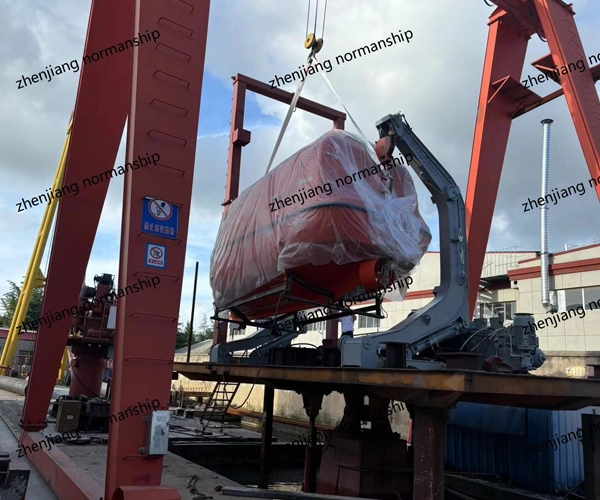In ship safety equipment, the davit is one of the most critical systems, primarily used for storing, lowering, and recovering lifeboats or liferafts. With the continuous advancement of maritime technology, gravity luffing arm type davits have become one of the most common types of davits on modern ships due to their ease of operation, high stability, and excellent emergency performance.

A gravity luffing arm type davit is a device that uses the force of gravity to move a lifeboat outboard and lower it into the sea. The key feature of this system is that it relies on gravity to swing the davit and lifeboat overboard, eliminating the need for complex power systems. This improves reliability and operational speed in emergency situations.
The system typically consists of a davit arm, pulleys, steel cables, a braking system, and a manual or electric winch. By operating a simple release mechanism, the davit arm naturally swings outward under the influence of gravity, smoothly lowering the lifeboat into the water, allowing the crew to quickly board and escape.
The basic operational process of the gravity luffing arm type davit is as follows:
Releasing Fixing Devices: Before use, the lifeboat and davit arm are usually secured by tying and locking mechanisms to prevent movement during the voyage. In an emergency, the first step is to release these fixing devices.
Davit Arm Extends Outboard: Through a release operation, the davit arm swings outward under its own weight, moving the lifeboat away from the ship's side, preventing any collision between the boat and the ship's hull.
Lowering the Lifeboat: The lifeboat is slowly lowered using the winch system, with the speed controlled by the braking system, ensuring a smooth and safe process for boarding and entering the water.
Unhooking and Launching the Lifeboat: Once the lifeboat reaches the water's surface and the crew is in position, the hook can be quickly released, allowing the lifeboat to freely move away from the mother ship.
Throughout this entire process, even in the event of power failure, system malfunction, or rough sea conditions, the davit arm will still be able to operate and lower the lifeboat as long as gravity is present. This makes it an extremely reliable life-saving device.
Davit Arm (Luffing Arm): Typically made of steel, designed to withstand the weight of the lifeboat and the harsh maritime environment.
Winch and Steel Cable System: Used to control the lifeboat's ascent and descent. The winch can be manually or electrically driven, with the steel cable connecting to the lifeboat’s lifting ring.
Braking System: Ensures the lowering process is smooth and can quickly stop when necessary.
Release Mechanism: Enables fast unlocking in an emergency, allowing the davit arm to begin its swinging motion.
Lifeboat Support and Fixing Device: Keeps the lifeboat stable during the voyage, preventing it from swaying or getting damaged.
High Reliability: It requires no external power, relying solely on gravity, so it can still operate even during power failure or other malfunctions.
Easy Operation: The design allows for quick and intuitive lifeboat deployment, enabling crew members to use it even in stressful situations.
Low Maintenance Costs: With a relatively simple structure and low failure rates, maintenance and inspections are straightforward.
Strong Adaptability: It can accommodate different ship types and varying sea conditions, making it especially suitable for emergency evacuations in harsh environments.
Compliance with International Standards: Most gravity luffing arm type davits are designed to meet SOLAS (International Convention for the Safety of Life at Sea) and classification society standards.
With the development of intelligent ship systems, some new gravity luffing arm type davits have started to incorporate smart monitoring systems. These systems can provide real-time feedback on the davit arm's status, lifeboat load, and winch operation, further enhancing the safety and intelligence of rescue equipment.